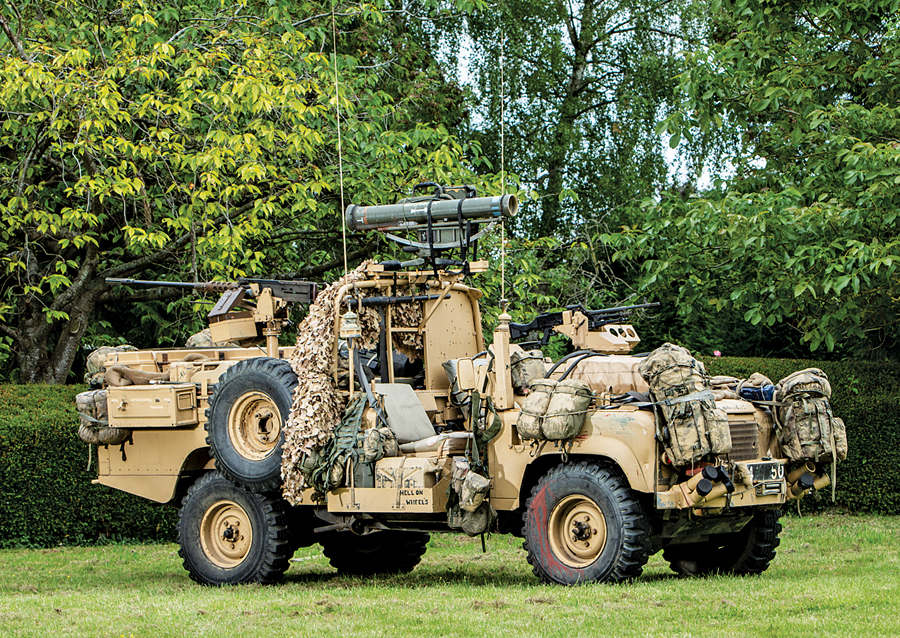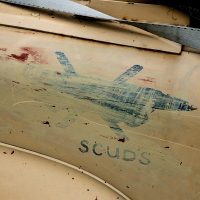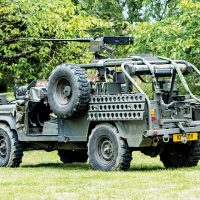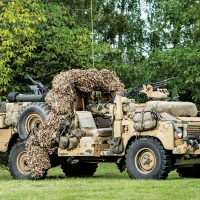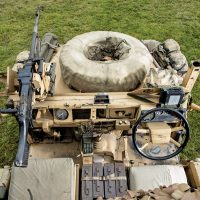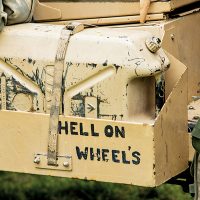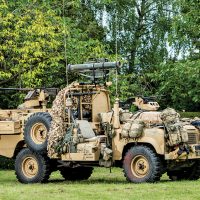SCM Analysis
Detailing
| Vehicle: | Four Veteran Special Forces Land Rovers |
| Years Produced: | (all Land Rovers) 1948–2016 |
| Number Produced: | About 2 million |
| Tune Up Cost: | $100 |
| Chassis Number Location: | This varies: On V8s, it is on the left side of block by dipstick tube |
| Engine Number Location: | Plate on bulkhead |
| Club Info: | Association of Land Rover Clubs |
| Website: | http://www.alrc.co.uk |
| Alternatives: | 1940–45 Willys MB/Ford GPW, 1971–2000 Steyr-Daimler Puch Pinzgauer, 1983 Humvee |
| Investment Grade: | C |
At Bonhams’ first auction of its new MPH offshoot at Bicester Heritage — the World War II RAF bomber base later used by the U.S. Air Force — a collection of eight military Land Rovers was among the early entries.
You can buy used — in some cases very used — British Army Land Rovers from various outlets in the U.K., but these were special – literally, as they were ex-Special Forces Landies. Special Forces is often used as a euphemism for Britain’s Special Air Service — the SAS — obliquely referred to in Army circles simply as “them.”
A bit of mobile warfare history
The SAS used Land Rovers for at least 50 years, having started off in Jeeps from its inception in 1941, along with its contemporaries Special Operations Executive and the Long Range Desert Group. All carried out, variously, reconnaissance and clandestine “ungentlemanly warfare” in Europe and North Africa during World War II — often behind enemy lines.
The Long Range Patrol on occasion provided transport for the SAS. Both SOE and LRDG were disbanded post-World War II, but the worth of small, highly mobile units for reconnaissance and guerrilla operations had been proven.
LRDG was replaced, effectively, by Mobility troops of the Special Air Service, whose members are experts in desert warfare — and able to field-repair breakdowns.
Moving to Land Rovers was a natural fit after the Jeeps. The SAS reportedly first used Land Rover S1s during the Oman conflict in the late 1950s. In 1967, the Series IIA came along, and at some point it was discovered that the best all-round color for desert camouflage, especially at long distances, was pink. And that’s how the legend of the Pink Panther was born, though later they reverted to standard desert color.
In 1985, the Defender 110 came on stream, operating behind Iraqi lines in the 1991 and 2003 Gulf Wars. In 2014, with the end of Landie production looming, it was announced that the SAS was to stop using Land Rovers after five decades. It’s reckoned that overall the British military has consumed 200,000 of them — with many still in service.
These lots sold for between $46,036 and $61,175 at Bonhams’ MPH sale at Bicester Heritage, Oxfordshire, U.K., on September 26, 2019.
At Bicester, among the lots were one Pink Panther, one that wasn’t (in green) and three Special Forces 110 V8s, one of them a prototype. We’ll look at the top four, as they all hit strong money for Land Rovers — although not as strong as Bonhams and the vendor would have liked.
Lot 195, 1968 Series IIA “Pink Panther”
This 109-inch wheelbase “Pink Panther” was the real deal. It was one of 72 production “Pinkies” and thought to be one of 10 left. Marshalls of Cambridge fitted them with extra fuel tanks, smoke-grenade launchers, radios, machine guns, rifles in wing boxes, flare guns, axle guards, water cans and bladders, sun compass, searchlights and even a bead breaker in a wing-mounted scabbard, as crews were expected to be able to repair their mounts in the field.
This one served in Oman, Jordan, Kenya and Belize until demobilized in 1984. It was presented well used and very original, complete with two copy General Purpose Machine Guns with current deactivation certificates and festooned with camo netting. It sold for £47,250, or $58,394. Another ’68 IIA Pink Panther, but in green (Lot 200) fetched $42,431.
Two Defender 110s
Creating great interest were two 1985 Defender 110s, “V8 SOV Truck Utility SAS,” Lots 199 and 201. These were part of a run of 39 built to military contract number FVE22B/695 and were loaded — heaped — with kit.
Said to be the only ones in private ownership, these have the heavy-duty chassis and Rover’s 3.5-liter V8 engine, which is also seen in the classic Range Rover. Lot 199, with 31,600 miles, served in the first Gulf War, Africa and Oman. It was fitted with copy .50-caliber machine guns. Like the others, it retains its military registration plates for display purposes. It sold for $59,785.
Lot 201 had 25,600 miles. This lot included pictures of when it was delivered new to Hereford — and while serving in the Gulf. It sold for $46,036.
I suspect the price difference was down to Lot 199 having more military service — and the emotive messages painted on its sides and snout: “7935 lbs heavy metal” and “Hell on Wheels” — plus noted Scud missile kills daubed on the front fender might have pushed the bidding along.
No combat — but the highest price
Interestingly, just where you would expect provenance to be everything, the SAS Landie that fetched the most money never saw combat.
Lot 197 was another 110 V8 SOV Truck Utility SAS, and it’s one of the 39 built. It is the left-hand-drive prototype built for the American Special Forces in 1993 — one of three produced. This one has a 5-speed transmission and was demonstrated in the Middle East — plus at arms exhibitions.
With two copy GPMGs and one copy .50-caliber machine gun, heavy-duty wire cutters clipped to the side and 21,950 miles, it just pipped the others to fetch $61,175, though the estimates on all three were far higher at £80k–£100k ($99k–$124k).
Land Rover expert Julian Shoolheifer said, “The Pink Panther is the right money, the prototype too. Factory V8 spec helps that a lot. £50,000 ($62k) is a bit of a ceiling with Land Rovers, and generally speaking, I think prices are currently around 2012 or so levels, with exceptions where things are very genuine and desirable.
“That said, serious cars are still serious money — with the right vehicle you can get six-figure sums — but those cars and buyers are rare.”
As our subject SAS Landies sold for similar money, we’ll take it that the market has gauged them correctly. What a contrast in sale prices between these combat-used desert heroes and the huge sums achieved by the pretend hard-men Defender SVXs from the last two James Bond films. ♦
